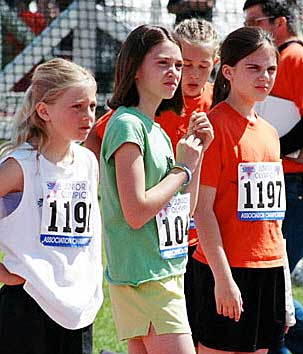Girls who play sports more than 8 hours per week are twice as likely as their less active peers to suffer a stress fracture, a new study1 finds.

Not surprisingly, the girls most at risk were those engaged in three activities (running, basketball and cheerleading/gymnastics) which involve repeated jumping and landing and place particularly high stress on bones. The risk of injury increases about 8 percent for each extra hour of activity over four hours per week.
The study, the first large general-population-based study of stress fracture rates among adolescent and young adult girls, is reported in the Archives of Pediatric Adolescent Medicine.
Cross-training, reduced hours playing sports recommended
The results prompted the study's authors to recommend that those "who supervise athletic programs for young female runners, basketball players, gymnasts, and cheerleaders promote varied training in non-impact or intermediate impact activities to decrease the cumulative amount of impact as well as reducing the hours spent training in [such] high-impact sport[s]."
Because physical activity during childhood and moderate activity during adolescence may increase bone mass density and thus help to protect against osteoporosis in adulthood, "It is very important that we encourage girls to be active, but to not spend 15 or 20 hours per week engaged in high impact sports", said Alison Field, ScD, the study's lead author and an Associate Professor of Pediatrics in the Division of Adolescent Medicine at Children's Hospital Boston in an interview with MomsTeam.com.
"Our study provides evidence that girls who participate in high impact sports, such as running, gymnastics, cheerleading, and basketball, are more likely to develop stress fractures, so we recommend cross-training with activities that are low or moderate impact and activities that use different patterns of movement, replacing some high impact training with low and moderate impact activity, and not engaging in extremely high levels of high impact sports. .
The study's recommendations, wrote Dr. Field in the study, are "particularly critical" given the movement of youth athletes "away from playing a different sport in each season to focusing on a single sport throughout the year. "
Other key study findings
- The overall rate of stress fractures among girls in the study (6831 girls aged 9 to 15 years) was 3.9%;
- The older a girl was when she got her first period (menarche) the higher the risk of developing a stress fracture, with each 1-year delay in onset of menarche was associated with an approximate 30% increase in risk, "Although delayed menarche can be caused by high levels of activity," Dr. Field told MomsTeam, "we found that regardless of level of activity, age at menarche was related to stress fracture." Nevertheless, she said, "we think it is prudent for parents to be aware of possible risks of high levels of training prior to menarche";
- Family history of osteoporosis or low bone mineral density (BMD) was strongly related to the risk of stress fracture, with such girls almost twice as likely to develop a stress fracture;
- No association was found between weight status (i.e. being underweight or overweight) or disordered eating and increased risk of stress fracture, results that Dr. Field found "surprising." While "not consistent with those from some previous studies," she wrote, the results were consistent with several other studies which did not find an association between disordered eating and stress fracture or high risk of stress fracture. It was "possible that we did not observe an association with disordered eating or body weight because we had a relatively small number of girls who were underweight [8.6%] or engaging in disordered eating [2.5%]."
Study limitations
- Nine out of ten in the study were white; it is was not clear whether the results applied to nonwhite female adolescents and young adults;
- The study relied on reporting from the mothers of the participants to ascertain stress fracture, so misclassification could have skewed the results;
- No information was available on some of the other predictors of stress fracture, such as factors related to biomechanics and bone microarchitecture.
Strengths outweigh weaknesses
Nevertheless, Dr. Field wrote, "the strengths of the study far outweigh the limitations," among them that it stands as the largest prospective study of adolescents, that data was collected at regular intervals (every 12 to 24 months), was gathered before the onset of stress fracture, and because information was available on a mother's history of low BMD and osteoporosis as well as information from the participant on age at menarche, body weight, disordered eating, and physical activity.
Facts about bone health
- More than half of adult bone calcium is acquired during adolescence;
- Peak bone mineral density (BMD), a major determinant of a woman's long-term risk of osteoporosis, is thought to be achieved by early adulthood;
- Although BMD is genetically determined to a large extent, physical activity is an important modifiable determinant of bone health;
- Very high levels of activity may be detrimental to bone health.
- As adolescence is a sensitive period for bone health, high levels of physical activity, particularly when accompanied by inadequate caloric intake, can result in suboptimal growth, although, at the same time high levels of activity before puberty may result in greater BMD. Adolescence may therefore be the most important period for examining factors predictive of stress fracture.
1. Field, AE, Gordon CM, PIerce LM, Ramappa A, Kocher MS. Prospective Study of Physical Activity and Risk of Developing a Stress Fracture Among Pre-Adolescent and Adolescent Girls. Arch. Ped. Adolesc. Med. 2011 (downloaded April 5, 2011 from www.archpediatrics.com)
Posted April 9, 2011








